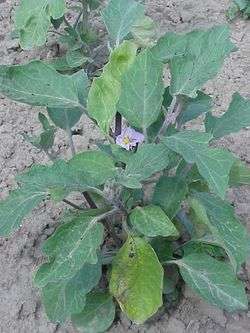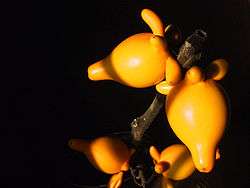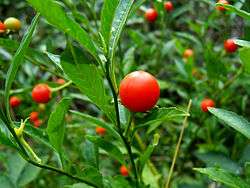Solanum
< Horticulture| Nightshades | |
|---|---|
| Genus: | Solanum |
| Family: | Solanaceae |
| Weediness: | Some species are problem weeds |
| Pollination: | Insects |
Solanum is a large, variable genus of annual plants and perennial plants, forbs, vines, sub-shrubs, shrubs, and small trees. They often have attractive fruit and flowers. Most are poisonous, but many bear edible fruits, leaves, or tubers, and the genus includes several cultivated species, including three major food crops: Tomatoes, Potatoes, and Eggplants.
Description
Annual, perennial, or tropical herbs or vines with alternate leaves and a watery sap. The flowers are in cymes or solitary, perfect, showy, 4-5 parted, with thick yellow anthers. Fruits are fleshy berries. Most species have a distinctive scent common to the genus.
Species
- Solanum aculeastrum - Sodaapple nightshade
- Solanum adscendens - Sonoita nightshade
- Solanum aethiopicum - Ethiopian nightshade or nakati
- Solanum americanum - Purple or glossy nightshade; American black nightshade; Poroporo
- Solanum arcanum
- Solanum aviculare - Poroporo
- Solanum bahamense - Bahama nightshade
- Solanum. bulbocastanum - Ornamental nightshade
- Solanum burbankii - Wonderberry
- Solanum campechiense - Redberry nightshade
- Solanum capsicastrum - False Jerusalem cherry
- Solanum capsicoides - Cockroach berry
- Solanum cardiophyllum - Heartleaf nightshade
- Solanum carolinense - Apple of Sodom, Horsenettle
- Solanum centrale - Australian desert raisin
- Solanum chenopodioides - Goosefoot nightshade
- Solanum citrullifolium - Watermelon nightshade
- Solanum clokeyi - Clokey's nightshade

- Solanum commersonii - Commerson's nightshade
- Solanum conocarpum - Marron bacoba
- Solanum crispum - Chilean potato vine
- Solanum davisensen - Davis horsenettle
- S. demissum - Dwarf wild potato
- S. dimidiatum - Torrey's nightshade
- S. diphyllum - Twinleaf nightshade
- S. donianum - Mullein nightshade
- S. douglasii - Greenspot nightshade
- S. drymophilum - Erubia
- S. dulcamara - Bittersweet
- S. elaeagnifolium - Silverleaf nightshade
- Solanum ellipticum - Potato bush
- Solanum erianthum - Mullein nightshade, Potato tree
- Solanum fendleri - Fendler's horsenettle
- Solanum ferox - Hairy-fruited eggplant, Thai hairy-fruited eggplant
- Solanum furcatum - Forked nightshade
- Solanum gayanum - Chilean nightshade
- S. gilo - Scarlet Eggplant, Gilo (Brazilian jiló)
- S. glacum -
- Solanum glaucophyllum - Waxyleaf nightshade
- Solanum gracilius - Slender nightshade

- S. haleakalense -
- Solanum heterodoxum - Melon-leaf nightshade
- Solanum hindsianum - Hinds' nightshade
- Solanum huaylasense
- S. hyporhodium - synonym of S. sessiliflorum
- S. imcompletum -
- S. incanum -
- Solanum incompletum - Popolo ku mai
- Solanum interius -
- Solanum jamaicense - Jamaican nightshade
- Solanum jamesii - Wild potato
- Solanum jasminoides - Jasmine nightshade
- Solanum khasianum - Indian nightshade
- Solanum lanceifolium - Lanceleaf nightshade
- Solanum lanceolatum - Orangeberry nightshade
- Solanum leptosepalum - Tigna potato
- S. linnaeanum - Apple of Sodom (Hawaii)
- Solanum lumholtzianum - Sonoran nightshade
- Solanum lycocarpum - Wolf Apple
- Solanum lycopersicum - Tomato
- S. macrocarpon -

- S. mammosum - Nipplefruit
- Solanum marginatum - White-margined nightshade
- S. mauritianum - Earleaf nightshade
- Solanum melanocerasum - Garden huckleberry
- Solanum melongena - Eggplant
- S. mucronatum - Pepino
- S. muricatum - Pepino
- Solanum nelsonii - Nelson's horsenettle
- Solanum nigrescens - Divine nightshade
- S. nigrum - Black or blackberry nightshade
- Solanum nudum - Forest nightshade
- Solanum parishii - Parish's nightshade
- S. pericifolium
- Solanum persicifolium - Berengena de playa
- Solanum peruvianum - Peruvian nightshade
- S. phureja -
- Solanum physalifolium - Hairy nightshade
- Solanum pimpinellifolium - Currant tomato
- Solanum pinnatisectum - Tansyleaf nightshade
- Solanum polygamum - Cakalaka berry

- Solanum pseudocapsicum - Jerusalem cherry
- Solanum pseudogracile - Glowing nightshade
- Solanum ptycanthum - Eastern black nightshade
- S. pyrifolium -
- Solanum quitoense - Naranjilla
- Solanum racemosum - Canker berry
- Solanum riedlei - Riedle's nightshade
- Solanum robustum - Shrubby nightshade
- Solanum rostratum - Texas thistle
- Solanum rugosum - Tabacon aspero
- Solanum. sandwicense - Hawaii horsenettle
- Solanum sarrachoides - Green nightshade
- Solanum seaforthianum - Brazilian nightshade
- Solanum sessiliflorum - Cocona
- Solanum sisymbriifolium - Sticky nightshade
- Solanum surattense -
- Solanum tampicense - Wetland nightshade
- Solanum tenuilobatum - San Diego nightshade
- Solanum tenuipes - Fancy nightshade
- Solanum torvum - Devil's fig
- Solanum triflorum - Cutleaf nightshade
- Solanum triquetrum - Texas nightshade
- Solanum tuberosum - Potato
- Solanum umbelliferum - Bluewitch nightshade
- Solanum viarum - Tropical soda apple
- Solanum villosum - Hairy nightshade
- Solanum viride - Green nightshade cv. form from Fiji: S. anthropophagorum
- Solanum wallacei - Wallace's nightshade, Catalina Nightshade
- Solanum wendlandii - Giant potatocreeper
- Solanum woodburyi - Woodbury's nightshade
- Solanum xanthi - Purple nightshade
Uses
Aside from the species grown as food crops, many species are cultivated for their showy flowers and fruits. Several species are weeds.
Maintenance
Monitoring for pests and diseases is very important for all species of Solanum.
Pests and diseases
Crown Gall
- Agrobacterium tumeifaciens
Stem Rot
- Erwinia carotovora var. atroseptica: Potato Black Leg
- Didymella lycopersicae
- Alternaria solani
- Ascochyta lycopersici
- Cercospora dulcamarae
- Mycosphaerella solani
- Phyllosticta pseudocapsici
- Stemphylium solani
- Phytophthora
- Phytophthora capsici
- Verticillium albo-atrum
- Alternaria solani
- Botrytis
- Phytophthora infestans
Root Rots
- Fusarium: Potato Dry Rot
- Helminthosporium solani: Potato Silver Scurf
- Phoma exigua var. foveata: Potato Gangrene
- Sporangospora subterranea: Potato Powdery Scab
- Streptomyces scabies: Potato Scab
Damping Off
Viruses
- Tomato Spotted Wilt Virus
- Mosaic
- Tobacco Mosaic Virus
Mop-top
- Potato Mop Top Virus
Spraing
- Tobacco Rattle Virus
- Potato Mop Top Virus
Leaf Roll
- Potato Leaf Roll Virus
Other Viri
- Potato Virus X
- Potato Virus Y
Root Knots
- Southern Root Knot Nematode: Meliodgyne incognita
- Javanese Nematode: Meliodgyne javanica
Potato Cyst Nematodes
Calcium Deficiency
Drought (causes hollow tubers on potatoes)
- Foxglove Aphid: Acyrthosiphon solani
- Bean Aphid: Aphis fabae
- Melon Aphid: Aphis gossypii
- Potato Aphid: Macrosiphum euphorbiae
- Green Peach Aphid: Myzus persicae
- Crescent-marked Lily Aphid: Neomyzus circumflexus
- Aster Leafhopper: Macrosteles facifrons
- Intermountain Potato Leafhopper: Empoasca filamenta
- Potato Leafhopper: Empoasca fabae
- Southern Garden Leafhopper: Empoasca solana
- Western Potato Leafhopper: Empoasca abrupta
Psyllids
- Potato Psyllid: Bactericerca cockerelli
- Citrus Whitefly: Dialeurodes citri
- Silverleaf Whitefly: Bemisia argentifolii
- Western Tarnished Plant Bug: Lygus hesperus
- Tarnished Plant Bug: Lygus lineolaris
- Garden Fleahopper: Halticus bractatus
- False Cinch Bug: Nysius raphanus (Western North America)
- Southern Green Stink Bug: Nezara viridula
Crickets
- Mole Crickets
- Western Flower Thrips: Frankliniella occidentalis
- Flower Thrips: Frankliniella thricti
- Onion Thrips: Thrips tabaci
- Melon Thrips: Thrips palmi
- Vegetable Leafminer: Liriomyza sativae
- American Serpentine Leafminer: Liriomyza trifolii
- Seedcorn Maggot: Delia platura
- Black Blister Beetle: Epicuata pennsylvanica
- Colorado Potato Beetle: Leptinotarsa decemlineata
- Eggplant Flea Beetle: Epitrix fuscula
- Western Potato Flea Beetle: Epitrix subcrinita
- Eggplant Tortoise Beetle: Gratiana pallidula
- False Japanese Beetle: Strigoderma arboricola
- Hop Flea Beetle: Psyllioides punctata
- June Beetles: Phyllophaga spp.
- Palestriped Flea Beetle: Systena blanda
- Potato Flea Beetle: Epitrix cucumeris
- Potato Stalk Borer: Trichobaris trinotata
- Tobacco Flea Beetle: .. Epitrix hirtipennis/
- Tuber Flea Beetle: Epitrix tuberis
- European Corn Borer: Ostrinia nubilalis
- Stalk Borer: Papaipema nebris
- Variegated Cutworm: Peridroma saucia
- Cabbage Looper: Trichoplusia ni
- Beet Armyworm: Spodoptera exigua
- Hornworms
- Orange Tortrix:Argyrotaenia citrana
- Potato Stem Borer: Hydraecia micacea
- (Solanum species are used as food plants by the larvae of some Lepidoptera species - see w:list of Lepidoptera which feed on Solanum.)
- Two-spotted Spider Mite: Tetranychus urticae
Millipedes
- Garden Symphylan: Scutigerella immaculata
Slugs and Snails
References
- Britton, Nathaniel Lord; Addison Brown (1913). An Illustrated Flora of the Northern United States and Canada, Volume 3 (second edition ed.). Dover Publications, inc.. pp. 164-167.
- Ann Fowler Rhoads and Timothy A. Block (2000). The Plants of Pennsylvania: An Illustrated Manual. Anna Anisko, illustrator. Morris Arboretum, University of Pennsylvania Press. pp. 684-685.
- P. D. Strausbaugh and Earl L. Core (1977). Flora of West Virginia (Second ed.). Seneca Books, Grantsville, W. Virginia. pp. 830-832.
- Christopher Brickell and Judith D. Zuk (1997). The American Horticultural Society A-Z Encyclopedia of Garden Plants. DK Publishing. pp. 964-965.
- Staff of the L. H. Bailey Hortorium (1976). Hortus Third: A Concise Dictionary of Plants Cultivated in the United States and Canada. Cornell University Press. pp. 1054-1056.
- Pirone, Pascal P. (1978). Diseases & Pests of Ornamental Plants (Fifth Edition ed.). John Wiley & Sons, New York. pp. 487.
- Cranshaw, Whitney (2004). Garden Insects of North America: The Ultimate Guide to Backyard Bugs. Princeton University Press. pp. 621.
- Pippa Greenwood, Andrew Halstead, A.R. Chase, Daniel Gilrein (2000). American Horticultural Society Pests & Diseases: The Complete Guide to Preventing, Identifying, and Treating Plant Problems (First Edition ed.). Dorling Kindersley (DK) Publishing, inc.. pp. 202.